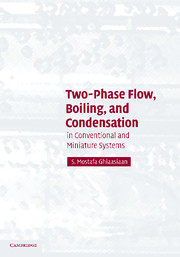Book contents
- Frontmatter
- Contents
- Preface
- Frequently Used Notation
- TWO-PHASE FLOW, BOILING AND CONDENSATION IN CONVENTIONAL AND MINIATURE SYSTEMS
- PART ONE TWO-PHASE FLOW
- 1 Thermodynamic and Single-Phase Flow Fundamentals
- 2 Gas–Liquid Interfacial Phenomena
- 3 Two-Phase Mixtures, Fluid Dispersions, and Liquid Films
- 4 Two-Phase Flow Regimes – I
- 5 Two-Phase Flow Modeling
- 6 The Drift Flux Model and Void–Quality Relations
- 7 Two-Phase Flow Regimes – II
- 8 Pressure Drop in Two-Phase Flow
- 9 Countercurrent Flow Limitation
- 10 Two-Phase Flow in Small Flow Passages
- PART TWO BOILING AND CONDENSATION
- APPENDIX A Thermodynamic Properties of Saturated Water and Steam
- APPENDIX B Transport Properties of Saturated Water and Steam
- APPENDIX C Thermodynamic Properties of Saturated Liquid and Vapor for Selected Refrigerants
- APPENDIX D Properties of Selected Ideal Gases at 1 Atmosphere
- APPENDIX E Binary Diffusion Coefficients of Selected Gases in Air at 1 Atmosphere
- APPENDIX F Henry's Constant of Dilute Aqueous Solutions of Selected Substances at Moderate Pressures
- APPENDIX G Diffusion Coefficients of Selected Substances in Water at Infinite Dilution at 25°C
- APPENDIX H Lennard–Jones Potential Model Constants for Selected Molecules
- APPENDIX I Collision Integrates for the Lennard–Jones Potential Model
- APPENDIX J Physical Constants
- APPENDIX K Unit Conversions
- References
- Index
7 - Two-Phase Flow Regimes – II
- Frontmatter
- Contents
- Preface
- Frequently Used Notation
- TWO-PHASE FLOW, BOILING AND CONDENSATION IN CONVENTIONAL AND MINIATURE SYSTEMS
- PART ONE TWO-PHASE FLOW
- 1 Thermodynamic and Single-Phase Flow Fundamentals
- 2 Gas–Liquid Interfacial Phenomena
- 3 Two-Phase Mixtures, Fluid Dispersions, and Liquid Films
- 4 Two-Phase Flow Regimes – I
- 5 Two-Phase Flow Modeling
- 6 The Drift Flux Model and Void–Quality Relations
- 7 Two-Phase Flow Regimes – II
- 8 Pressure Drop in Two-Phase Flow
- 9 Countercurrent Flow Limitation
- 10 Two-Phase Flow in Small Flow Passages
- PART TWO BOILING AND CONDENSATION
- APPENDIX A Thermodynamic Properties of Saturated Water and Steam
- APPENDIX B Transport Properties of Saturated Water and Steam
- APPENDIX C Thermodynamic Properties of Saturated Liquid and Vapor for Selected Refrigerants
- APPENDIX D Properties of Selected Ideal Gases at 1 Atmosphere
- APPENDIX E Binary Diffusion Coefficients of Selected Gases in Air at 1 Atmosphere
- APPENDIX F Henry's Constant of Dilute Aqueous Solutions of Selected Substances at Moderate Pressures
- APPENDIX G Diffusion Coefficients of Selected Substances in Water at Infinite Dilution at 25°C
- APPENDIX H Lennard–Jones Potential Model Constants for Selected Molecules
- APPENDIX I Collision Integrates for the Lennard–Jones Potential Model
- APPENDIX J Physical Constants
- APPENDIX K Unit Conversions
- References
- Index
Summary
Introductory Remarks
In Chapter 4 the basic gas–liquid two-phase flow regimes along with flow regime maps were reviewed. The discussion of flow regimes was limited to empirical methods applicable to commonly applied pipes and rod bundles. In this chapter mechanistic two-phase flow regime models will be discussed.
Empirical flow regime models suffer from the lack of sound theoretical or phenomenological bases. Mechanistic methods, in contrast, rely on physically based models for each major regime transition process. These models are often simple and rather idealized. However, since they take into account the crucial phenomenological characteristics of each transition process, they can be applied to new parameter ranges with better confidence than purely empirical methods. Some important investigations where regime transition models for the entire flow regime map were considered include the works of Taitel and Dukler (1976), Taitel, Bornea, and Dukler (1980), Weisman and co-workers (1979, 1981), Mishima and Ishii (1984), and Barnea and co-workers (1986, 1987). The derivation of simple mechanistic regime transition models often involves insightful approximations and phenomenological interpretations. The review of the major elements of the successful models can thus be a useful learning experience.
In this chapter only conventional flow passages (i.e., flow passages with) will be considered. There are important differences between commonly applied channels and mini- or microchannels with respect to the gas–liquid two-phase flow hydrodynamics. Two-phase flow regimes and conditions leading to regime transitions in mini- and microchannels will be discussed in Chapter 10.
- Type
- Chapter
- Information
- Two-Phase Flow, Boiling, and CondensationIn Conventional and Miniature Systems, pp. 186 - 206Publisher: Cambridge University PressPrint publication year: 2007



